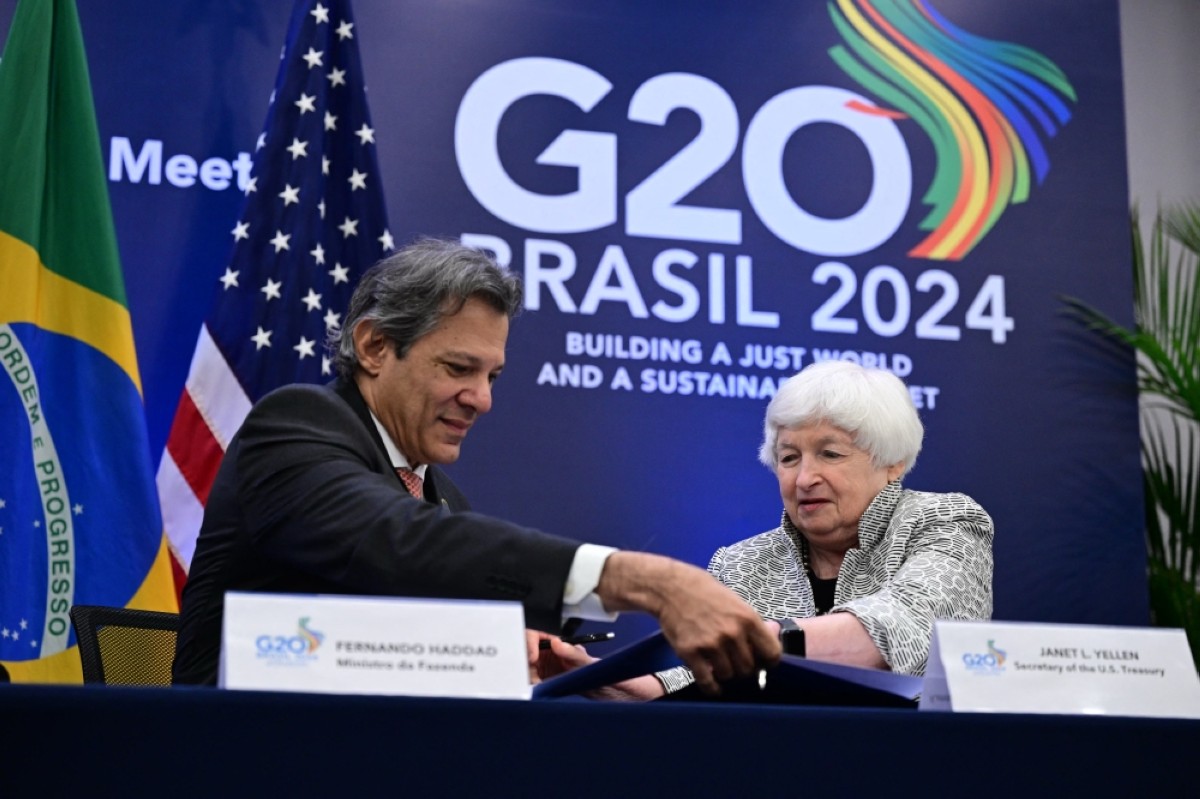US grows at 3.2%, Europe struggles NBK ECONOMIC REPORT
KUWAIT: Global economic prospects have diverged in recent months, with the US seeing solid growth and proving resilient to the current elevated interest rate environment.

However, within Europe, conditions are much weaker with – alongside high interest rates – more restrictive fiscal policy, less exposure to the booming tech sector and greater exposure to sluggish global trade weighing heavily on activity.
Meanwhile, in a historic move, the Bank of Japan tightened monetary policy on a view that inflation is finally heading sustainably back up to the 2 percent target, despite still-muted domestic activity. Elsewhere in Asia, the Chinese economy got off to a decent start in Q1, though structural issues compounded by a moribund property sector continue to pose questions over the strength and durability of the recovery. More positively, India continues to deliver above-expected growth rates, and remains the fastest-growing major economy.
Underpinned by a robust job market and resilient consumer spending, the US economy has defied slowdown predictions, growing by a solid 3.2 percent (annualized) in Q4 2023 versus expectations of a 2 percent rise. Although softened from +4.9 percent in Q3, there seem to be no major signs of a downturn. Household consumption remained largely intact (+3 percent y/y), while residential investment rose for the second quarter and business investments increased.
This said, economic indicators thus far in Q1 have been relatively underwhelming, with retail sales (+0.6 percent m/m) and industrial production (+0.1 percent m/m) recovering somewhat in February after outsized drops in January, and consumer sentiment still somewhat subdued. As a result, GDP growth could slow to 1.5-2 percent in Q1, near its trend rate.
Offering support to the ongoing momentum, the labor market remains solid despite a mixed set of data in February, with strong job gains (+275K) but substantial downward revisions to the previous two months’ data, ebbing but still-robust wage growth (4.3 percent y/y), and a pickup in the unemployment rate (3.9 percent), albeit historically a low level.
Consumer price inflation has broadly decelerated, with the core rate receding to 3.8 percent y/y in February. Although well off its peak of 6.6 percent in September 2022, progress on disinflation seems to have lost steam, with the core rate moderating only marginally from 4 percent in October. With the Fed funds target rate now at 5.25-5.50 percent, real policy rates are in positive (and restrictive) territory, which risks causing a sharp downturn if rates are kept too high for too long.
But given the robust economic picture, the Fed wants to achieve greater confidence that inflation is heading back to the 2 percent target before shifting policy. For now, the FOMC, in its latest dot-plot projections, continued to see three rate cuts later this year and looked set to slow the pace of the bank’s quantitative tightening program despite hotter inflation data so far this year.
Europe growth weaker
Euro Area GDP was unchanged in Q4 2023 after falling 0.1 percent q/q in Q3. Growth could edge up to 0.8 percent this year based on the European Commission’s forecast, following a 0.5 percent rise in 2023 – though this is still a downgrade from an earlier forecast of 1.2 percent. France, Germany, and Italy will likely see slower growth, while others like Greece and Spain could deliver better outcomes. Growth should be helped by easing inflation, rises in real wages, and likely ECB interest rate cuts. However, the composite PMI in February remained in contraction for a ninth straight month at 47.2, signaling still-weak business conditions overall. Inflation fell to 2.6 percent y/y (from 2.8 percent in January), with the core rate coming in at 3.1 percent from 3.3 percent the previous month. Wages were up 5.6 percent in Q3 but could start to tick down as inflation drops towards the ECB’s 2 percent inflation goal in 2025. Given weak growth and inflation now below that in the US, the ECB could now start cutting interest rates earlier (and more aggressively) that the Fed, not later than the bank’s meeting in June.
The UK economy showed some signs of recovery, growing 0.2 percent m/m in January 2024 versus -0.1 percent in December after recording a minor recession in H2 2023. The IMF expects growth to reach 0.6 percent in 2024 versus 0.1 percent in 2023, with a somewhat positive outlook stemming from resilient wage growth (5.2 percent in December) and moderating inflation (3.4 percent in February). Additionally, the March budget announced that fiscal policy will be tightened by less than previously planned (ahead of a likely general election later this year), providing some help for household disposable incomes. With inflation trending steadily lower, the Bank of England could also start to cut interest rates in June.
Japan escapes recession
GDP growth was revised up for Q4 2023 to +0.1 percent q/q from -0.1 percent q/q in the previous estimate, following a large 0.8 percent drop in Q3, helping the country to avoid a technical recession. This was due to an upgraded estimate for private investment and despite steeper declines in private consumption. A favorable trade balance partly offset weak domestic activity, with Japanese goods more competitive amid a weaker yen. Sluggish economic growth is expected in the current quarter, with leading indicators, including the PMI, signaling a continued contraction in manufacturing, weak household consumption, and a modest rise in retail sales. However, the expanding service activity in February, strong exports, and tumbling energy imports could provide some support.
Consumer price inflation reversed the declining trend and rose 2.8 percent in February from 2.2 percent in January, while core inflation also accelerated to 2.8 percent from 2 percent y/y. However, recent union negotiations have delivered decades-high wage growth to workers, moving wages into positive territory – a prerequisite for inflation being sustained at or above the 2 percent target according to the Bank of Japan (BOJ). This pushed the bank in March to abandon its eight-year negative interest rate policy and discontinue yield curve control (which capped long-term bond yields). But the small size of the widely anticipated rate move, the absence of commitment to further increases and the BOJ’s pledge to keep buying government bonds all signaled a continuation of the bank’s accommodative stance and resulted in the yen and government bond yields falling post-announcement.
Chinese economy picked up
Economic growth surpassed the government’s target of 5 percent in 2023, accelerating to 5.2 percent y/y, helped by base effects from severe “COVID-Zero” lockdowns in the preceding year. But excluding the pandemic period 2020-22, this was a multi-decade low. Recent economic indicators have painted a rosier picture. The trade data surprised positively as exports grew 7.1 percent y/y in the January-February period (on average) while imports edged up 3.5 percent y/y, signaling a slight pickup in domestic consumption. Industrial production and retail sales were also above forecast.
Consumer prices rose 0.7 percent y/y in February following four months of deflation, though this could have been impacted by the Lunar New Year holiday falling in February compared to January in the previous year. Moreover, the decline in producer prices worsened to 2.7 percent y/y in February, signaling further deflationary pressure in the pipeline. The composite PMI remained steady in the first two months of the year at 50.9, but manufacturing activity was in contraction for the fifth month in a row. The uneven economic performance highlights the challenges the government will face in achieving its “around 5 percent” GDP growth target for 2024, considering property market and demographic headwinds.
In response to the subdued economic picture, the People’s Bank of China kicked off the year with monetary policy loosening, lowering the reserve requirement ratio by 50 bps in January. In addition, state-owned banks earmarked $8 billion in funds for eligible property projects. The authorities also introduced measures to boost stock market valuations, such as restrictions on short selling, increasing margin requirements, and suspending broker lending of shares. The government has reaffirmed its commitment to supporting economic conditions, but details are scant.
India’s economy continued to surprise positively, growing by a solid 8.4 percent y/y in Q3 of FY23/24 (October-December), much higher than the 6.6 percent forecast, accelerating from an upwardly-revised 8.1 percent in Q2 on strong public investments. A continued push by the government to accelerate capital spending and potentially create more job opportunities before this year’s general election has been a key growth driver in recent periods. However, private consumption lagged, rising at a slower 3.5 percent pace, though better than +2.4 percent the previous quarter.
On the back of a solid performance in Q3 and upward revisions to H1 growth, the government raised the growth forecast for the full-year to 7.6 percent from the 7.3 percent projected earlier. Despite the latest improvement, headwinds persist for private consumption, mainly in the rural segment where the impact of erratic rains is more visible, as the official forecast projects the slowest private consumption growth in over two decades outside the pandemic period at 3 percent for the current fiscal year.
Consumer price inflation remained broadly stable at 5.1 percent y/y in February on elevated food prices after irregular rains impacted agricultural production. The Reserve Bank of India has kept the repo rate steady at 6.5 percent since April 2023 as it grapples with food price uncertainty and an unclear inflation outlook amid worsening geopolitics and volatile oil prices.











